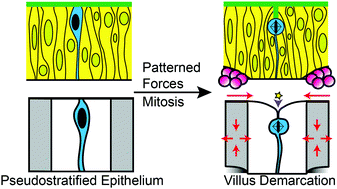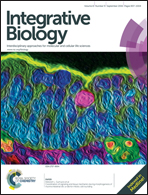Coordination of signaling and tissue mechanics during morphogenesis of murine intestinal villi: a role for mitotic cell rounding†
Abstract
Efficient digestion and absorption of nutrients by the intestine requires a very large apical surface area, a feature that is enhanced by the presence of villi, fingerlike epithelial projections that extend into the lumen. Prior to villus formation, the epithelium is a thick pseudostratified layer. In mice, villus formation begins at embryonic day (E)14.5, when clusters of mesenchymal cells form just beneath the thick epithelium. At this time, analysis of the flat lumenal surface reveals a regular pattern of short apical membrane invaginations that form in regions of the epithelium that lie in between the mesenchymal clusters. Apical invaginations begin in the proximal intestine and spread distally, deepening with time. Interestingly, mitotically rounded cells are frequently associated with these invaginations. These mitotic cells are located at the tips of the invaginating membrane (internalized within the epithelium), rather than adjacent to the apical surface. Further investigation of epithelial changes during membrane invagination reveals that epithelial cells located between mesenchymal clusters experience a circumferential compression, as epithelial cells above each cluster shorten and widen. Using a computational model, we examined whether such forces are sufficient to cause apical invaginations. Simulations and in vivo data reveal that proper apical membrane invagination involves intraepithelial compressive forces, mitotic cell rounding in the compressed regions and apico-basal contraction of the dividing cell. Together, these data establish a new model that explains how signaling events intersect with tissue forces to pattern apical membrane invaginations that define the villus boundaries.



 Please wait while we load your content...
Please wait while we load your content...